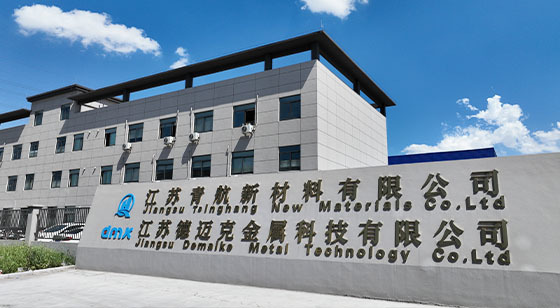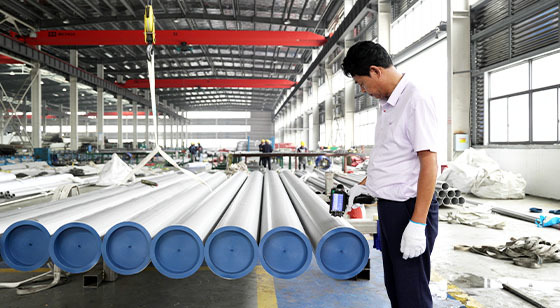What are the differences between stainless steel seamless pipes and stainless steel welded pipes?
Release time:
2025-03-26
Seamless stainless steel pipes, also known as stainless steel seamless tubes, are manufactured by piercing steel ingots or solid billets to create capillary tubes, which are then hot-rolled, cold-rolled, or cold-drawn.
Difference between seamless stainless steel pipes and welded stainless steel pipes:
1. Different pipe manufacturing processes.
Seamless stainless steel pipes, also known as seamless stainless steel tubes, are made from steel ingots or solid billets through piercing to form capillary tubes, then hot-rolled, cold-rolled, or cold-drawn.
Welded stainless steel pipes are made from stainless steel sheets.
2. Weld seam.
Decorative 304 welded stainless steel pipes show a weld seam due to their manufacturing process, while seamless steel pipes, as their name suggests, have no weld seam. High-quality decorative welded stainless steel pipes have weld seams that are fully nitrogen-protected.
3. Thickness.
The raw steel strip for welded stainless steel pipes undergoes rolling, resulting in relatively uniform thickness. The finished welded pipes come in various thicknesses, both thin and thick. However, the thickness of seamless stainless steel pipes is often uneven and generally thicker.
4. Weldability.
Generally, there are some differences in the chemical composition between 304 welded stainless steel pipes and seamless stainless steel pipes. The steel used for seamless stainless steel pipes only meets the basic requirements of ASTM. The steel used for welded stainless steel pipes contains chemical components suitable for welding, such as silicon, sulfur, manganese, oxygen, and ferritic elements, mixed in certain proportions. These can produce a weld melt that easily transfers heat during welding, thus ensuring complete penetration of the weld seam. Seamless stainless steel pipes, lacking these elements, encounter various instabilities during welding, making it difficult to achieve a strong and fully penetrating weld.
4. Corrosion Resistance.
Generally, the corrosion resistance of both seamless and welded stainless steel pipes of the same material is essentially the same.
5. Price.
Seamless steel pipes are more expensive than welded stainless steel pipes.
6. Overall Quality
Generally, the quality of 304 welded stainless steel pipes is superior to seamless stainless steel pipes. This is because welded stainless steel pipes are made from precision cold-rolled sheets that have passed inspection, so defects are mainly concentrated in the welds. 304 seamless stainless steel pipes, however, are made by punching stainless steel billets, resulting in many tears in the pressed pipe walls. Eddy current testing shows that the defect rate of welded stainless steel pipes is typically lower than that of seamless stainless steel pipes.
6. Surface.
The surface requirements for seamless pipes are not strict; there may be inconspicuous spots. Stainless steel decorative pipes have stricter surface treatment requirements.
7. Applications.
Seamless pipes are mainly used in industry. Decorative pipes have wider applications, primarily in welding for decorative purposes. However, as the technology for decorative stainless steel pipes improves, thick-walled decorative pipes are also replacing some seamless steel pipes.
Seamless stainless steel pipes are long steel materials with a hollow cross-section and no weld seam around the periphery.
Welded stainless steel pipes are also steel with a hollow cross-section. However, they are made by rolling and welding steel sheets, resulting in a weld seam.
Characteristics of Seamless Stainless Steel Pipes
First, the thicker the wall thickness of this product, the more economical and practical it is; the thinner the wall thickness, the higher the processing cost will be. Second, the process determines its limitations. Seamless steel pipes generally have low precision: uneven wall thickness, low internal and external surface brightness, high fixed-length cost, and pinholes and black spots on the internal and external surfaces are difficult to remove. Third, its detection and shaping must be handled offline. Therefore, it demonstrates its superiority in high-pressure, high-strength, and mechanical structural materials.
Types of Stainless Steel Pipes
According to the rolling method, they are divided into hot-rolled, hot-extruded, and cold-drawn (rolled) stainless steel pipes.
According to the different metallographic structures of stainless steel, they are divided into half-ferritic half-martensitic stainless steel pipes, martensitic stainless steel pipes, austenitic stainless steel pipes, and austenitic-ferritic stainless steel pipes, etc.
Specifications and Appearance Quality of Stainless Steel Pipes
A. According to GB14975-94 "Seamless Stainless Steel Pipes", the standard length of steel pipes (non-fixed length) is 1.5-10m for hot-rolled steel pipes, and 1m or more for hot-extruded steel pipes. For cold-drawn (rolled) steel pipes with a wall thickness of 0.5-1.0mm, the length is 1.0-7m; for those with a wall thickness greater than 1.0mm, the length is 1.5-8m.
B. The diameter of hot-rolled (hot-extruded) steel pipes ranges from 54 to 480mm in 45 specifications; the wall thickness ranges from 4.5 to 45mm in 36 specifications. The diameter of cold-drawn (rolled) steel pipes ranges from 6 to 200mm in 65 specifications; the wall thickness ranges from 0.5 to 21mm in 39 specifications.
C. The inner and outer surfaces of the steel pipes shall not have defects such as cracks, folds, splits, cracks, roll-over, delamination, and scabs. These defects shall be completely removed (except for pipes for mechanical processing). After removal, the wall thickness and outer diameter shall not exceed the negative tolerance. Other minor surface defects that do not exceed the allowable negative tolerance need not be removed.
D. Allowable depth of straightness. For hot-rolled and hot-extruded steel pipes with a diameter less than or equal to 140mm, the depth shall not exceed 5% of the nominal wall thickness, and the maximum depth shall not exceed 0.5mm; for cold-drawn (rolled) steel pipes, it shall not exceed 4% of the nominal wall thickness, and the maximum depth shall not exceed 0.3mm.
E. The two ends of the steel pipe shall be cut at a right angle and the burrs shall be removed.
TSINGHANG NEW MATERIAL
International Business:+86-13382270060
After-sales service:+86-17761608887
Sales Consultant: Manager Liu +86-13333688292
Email: jiangsuqh@88.com
Address: 12 Xiaqinglonggang East Road, Jingjiang Economic Development Zone, Taizhou
Copyright © 2025 JIANGSU TSINGHANG NEW MATERIAL CO., LTD








